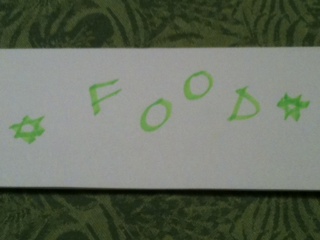Earlier this week I attended KosherFest, the Kosher food industry’s annual trade show in Secaucus, NJ. Questions about kosher food identity and its place on the table of health-conscious consumers kept popping up. At a panel discussion on trends in kosher food, a person in the audience wondered about the would be fate of traditional Jewish food with all the sushi and foods from other cuisines to which Jews are gravitating these days. This begged the question of what is ‘Jewish food,’ which is just like the question of ‘what is art.’
I recently visited the Hirshhorn Museum with my oldest son, a musician (farewellrepublic.bandcamp.com) based in Greenpoint, NY. When we came upon an installation in the ColorForms exhibition, I turned to my son and asked kiddingly, ‘so, what is art?’ He did not hesitate when he shot back, ‘if it’s in the museum, it’s art.’ He later added, ‘if the artist says it’s art, then it is.’ So, by the same token, if a Jew says a food is Jewish, that it is. Especially so, if the food is part of our collective Jewish culinary experience.
The person asking the question at the Kosher Fest tacitly equated Jewish food to Jewish Eastern European food. A panelist Jewish food historian, Gil Marks, Encyclopedia of Jewish Food, answered that, in his opinion, there is no such thing as ‘Jewish Food.’ I agree.

The Jews who emigrated from Judea to Europe brought with them neither kreplach nor gfilte fish. Nor did the Jews of the Iberian Peninsula bring with them borekas, or, the Jews of Yemen, Kubaneh. Generally speaking, wherever Jews landed, they adopted and adapted local and seasonal foods to their customs. As Jews were dispersed to the four corners of the earth, one can argue that all global cuisines are in essence Jewish cuisine.
I serve gfilte fish as well as Yemenite fish to my family and friends. Neither is more Jewish than the other. But there is one food I dare call ‘Jewish food’ because of its unique ceremonial role in our lives. It is the Sabbath bread. Hallah is one. Yet each Jewish community has one. On Friday night, Yemenite Jews bless on pita bread. But they have their Sabbath bread, Kubanah, on Shabbat morning. In it’s essence, though, Kubanah is Hallah baked in a tightly covered pot. It is made with yeast, but with higher fat content. My nephews in Israel love it when the dough is spread with maple syrup, which is definitely not a staple of the Yemenite kitchen. Does it make it less of a Kubaneh? No, it’s just a new twist on something old. Each generation should reserve its right to invent and innovate.
The second question about traditional Jewish food came up at the social group dinner at Solo, NYC, the evening before the Kosher Fest. Paula Shoyer, The Kosher Baker, wondered whether there is room for the traditional foods, such as Kugel, on the weekly Shabbat table, or should they be reserved only for holidays. She added that meals should feature more vegetables. Good points at a time where there is elevation in weight issues and diet-induced health ailments. Leah Shapira, Fresh & Easy Kosher Cooking, retorted with don’t say it to her children. They apparently ask for these traditional foods every Shabbat. Many of us are passionate about preserving our culinary traditions. I’d say, with consuming moderation (portion control), some healthy substitutions (olive oil, instead of margarine, etc.), judicious use of sugar and salt (as condiments, not main ingredients), you can have your Kugel and eat it. And, definitely, put less processed foods and more fresh fruits and vegetables on your table.
The installation at the ColorForms exhibition that prompted my question of what is art was a sculpture by Fred Sandback. It was dozen ceiling-to-floor columns made with the kind of red and black yarn that you buy in a store. The columns reshaped the gallery space. That reshaping—the different and new way in which it made us perceive the space—was art. A similar reshaping of the space of Jewish food has been taking place. It’s the same space, the same Jewish food, only this wonderfully colorful and diverse space has been minimized so we can all enjoy the different aspects of global Jewish cuisine. The healthiest aspects, that is.
What do you think?
Inspire, be Inspired!




